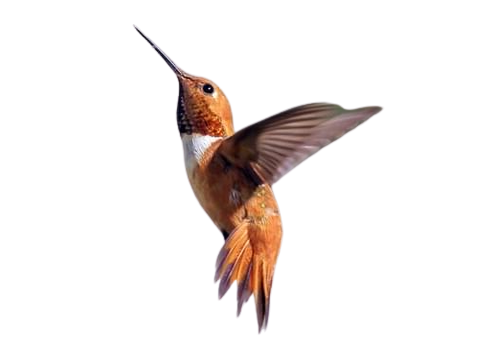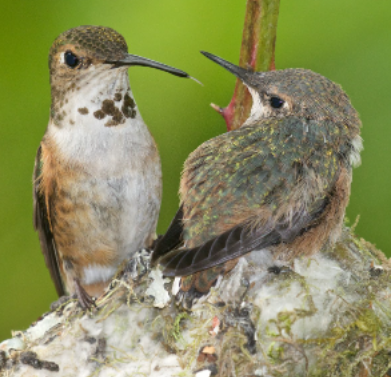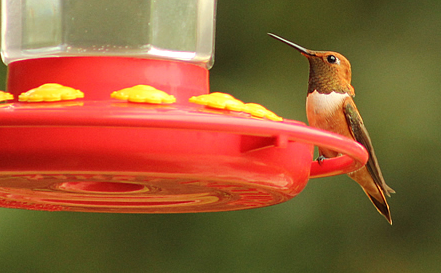The rufous hummingbird is a small hummingbird known for its long, straight, and slender bill. They are only 3.1 inches long, including their long bill. These birds are known for their relentless attacks on the flowers and feeders. You can locate the Rufous hummingbirds in California during spring, Pacific Northwest and Alaska during summer, and in the Rocky Mountains during fall. The male Rufous hummingbirds have white breasts, iridescent orange-red throat patch or gorget, and Rufous flanks and tail. Some of the male individuals also have green-back and crowns. The female Rufous hummingbirds have orange, white, and some green feathers.

The immature Rufous hummingbirds are most like the female Rufous hummingbirds. The down-strokes of the Rufous hummingbirds help them to support their body weight during hovering. Usually, the male Rufous hummingbirds have shorter wings as compared to females. Let’s know more about the Rufous hummingbirds.
Scientific name
The scientific name of the Rufous hummingbird is Selasphorus Rufus.
Conservation
From 1966 to 2014, the Rufous hummingbird’s population decreases with time, with a commutative decline of 62%. This decline is mainly due to a decrease in the insect population and the decrease in the favorite flowers of the Rufous hummingbirds. The Rufous hummingbirds are at risk of becoming threatened without taking any conservation action.
Size and shape

The rufous hummingbird is a small-sized hummingbird with 2.8 to 3.5 inches in length. Both males and females have weights between 0.1 to 0.2oz with a wingspan of 4.3 inches. Their short wings never reached their tail during perching. Their size is the same as the Ruby-throated hummingbirds.
Color Pattern

The male and the female hummingbirds are slightly different in their color pattern. The male Rufous hummingbird has bright orange on its back and belly and a vivid iridescent-red throat. In comparison, the females and immature Rufous hummingbirds have green above, green tails with Rufous patches, and an orange spot at the throat.
Behavior
Rufous hummingbirds are known for their fast speed to get the nectar from one flower to other. They like to perch around feeders while not feeding. Both of their sexes are aggressive and often found chasing the other species in their territory. They like to pick the insects from spider webs and also out of the air. The male hummingbirds performed a J-shaped flight when the females entered their territory.
Habitat
The open or shrubby areas, forest openings, yards, and parks are the favorite places of the Rufous hummingbirds for breeding. But sometimes, they also breed in forests, thickets, swamps, and meadows. You can also locate the Rufous hummingbirds in the meadows up to 12,600 feet elevation during their migration. The hummingbirds live in Mexico in the oak, pine, and juniper woods during the winter season at 7500 to 10000 feet elevation.
Food
Like all the other hummingbird species, Rufous hummingbirds like to get the sweet nectar from colorful flowers. Their favorite nectar flowers include the columbine, penstemon, Indian paintbrush, mints, lilies, fireweeds, heaths, currants, larkspurs, and scarlet gilia. To get the essential protein, they also eat the insets, including the gnats, midges, and flies.
Nesting
 The female Rufous hummingbirds travel to their breeding grounds for breeding. They build their nests 30 feet above the ground on the trees such as Sitka Spruce, western red cedar, Douglas-fir, pines, birch, maples, and thimbleberry. Sometimes they also build more than one nest at a few yards distance. Females use soft plant stems along with spider webs to build their nests. They like to decorate their nests with lichen, moss, and bark. Other individuals can also reuse the nests in the next year. The female Rufous hummingbirds lay 2 to 3 eggs. Their tiny white eggs only have 0.5 inches in length and 0.3 inches in width.
The female Rufous hummingbirds travel to their breeding grounds for breeding. They build their nests 30 feet above the ground on the trees such as Sitka Spruce, western red cedar, Douglas-fir, pines, birch, maples, and thimbleberry. Sometimes they also build more than one nest at a few yards distance. Females use soft plant stems along with spider webs to build their nests. They like to decorate their nests with lichen, moss, and bark. Other individuals can also reuse the nests in the next year. The female Rufous hummingbirds lay 2 to 3 eggs. Their tiny white eggs only have 0.5 inches in length and 0.3 inches in width.
Migration
Rufous is a long migrant hummingbird species that travel to its breeding grounds in Alaska and northwest Canada during winter. They return to the Rocky Mountains in summer and fall after traveling to the Pacific Coast in spring. Rufous hummingbirds travel 4000 miles during their migration. In recent years, the Rufous hummingbirds have been seen in the southeast U.S.
Songs and Calls
The male and female Rufous hummingbirds are known for making the chip notes while they are intruding on the other birds. The females usually make the chu-chu-chu-chu sounds.
Backyard tips to attract Rufous hummingbirds

You can attract the Rufous hummingbirds in your garden by growing the hummingbird’s favorite flowers or by putting the hummingbird feeders. But they can make it very difficult for the other hummingbird species to visit your garden as they are very aggressive. You can make your own nectar with 4 parts of water and one part of sugar to attract these cute birds. Make sure to change the nectar before it’s become cloudy, as the cloudy nectar is toxic to hummingbirds.
Cool facts about Rufous hummingbirds
- Rufous hummingbirds migrate long distances as compared to other birds in the world with respect to their size. They migrate 4000 miles, making a clockwise circuit throughout western North America each year.
- Rufous hummingbirds can also breed with the other species of the hummingbirds, which makes them very difficult to identify them.
- They have a strong memory and remember the places they visited the last year. Even after the long migration, they remember their feeding grounds and specific locations of the feeders.
- The oldest known Rufous hummingbird was 8 years and 11 months old, which was found in British Columbia during the branding operation.
- Rufous hummingbirds are very aggressive, you may often see them chasing the other hummingbird species, and even they also chase the other Rufous hummingbirds as well. They are also very aggressive to other unwanted audiences on the feeder, such as bees, wasps, and other nectar-consuming creatures.
- Rufous hummingbirds usually live in highly populated areas, making them exposed to predators such as cats.
- Hummingbirds flap their wings very fast to maintain their hovering across the feeders. A Rufous hummingbird’s wing flapping speed is 52-62 wing beats per second.
What is the average life span of the Rufous hummingbirds?
The average life span of hummingbirds can be anywhere between 1 year to 5 or 6 years. If a hummingbird survives for the first year, the chances of his life are increased. The age of the oldest known Rufous hummingbird was 8 years and 11 months.
What are the main distinguishing features of the Rufous hummingbirds?
The male Rufous hummingbirds have bright orange back and belly. Their vivid iridescent-red throat is also very unique as compared to other species of hummingbirds. The female has green above, with the Rufous patches on the green tail. They often have an orange spot on their throat.
What flowers do Rufous hummingbirds like the most?
The red tubular flowers are the favorite flowers of the Rufous hummingbirds, which include the penstemon, red columbines, paintbrush, scarlet sage, and gilia. They also like to get the artificial nectar from hummingbird feeders.
Are Rufous hummingbirds rare?
Although the Rufous hummingbird population is declining, they are still very common. You can commonly locate them in their wintering and breeding grounds and along their migratory routes.
How fast can the Rufous hummingbirds fly?
The Rufous hummingbirds can fly at the speed of 20 to 30 miles per hour. Even the male’s Rufous hummingbird speed increased from this limit when they made a dive to impress the females.
Are the Rufous hummingbirds territorial?
Yes, Rufous hummingbirds are territorial and known for their aggressive nature. They don’t like the other birds in their territories. Even they have often seen chasing the other Rufous hummingbirds as well. Rufous hummingbirds are known for being the most aggressive and territorial of all the hummingbird species.
Conclusion
The rufous hummingbird is one of the small hummingbird species, which can only grow 2.8 to 3.5 inches in length with 0.1 to 0.2oz weight. They are known for their aggressive nature as compared to all the other species. They travel around 4000 miles during their migration from breeding grounds to wintering grounds. You can attract the Rufous hummingbirds in your garden by providing the nectar feeders. They also love to catch the flying insects from around the feeders.


